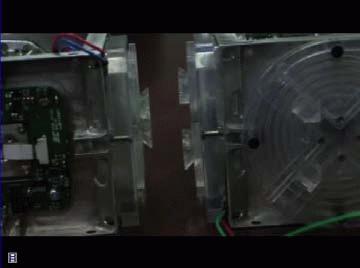Wei-Min Shen returned from the 26th Army Science Conference with an award plaque for work creating a better linkage system for his supermodular robot system, one that can "self-heal" if problems arise.
The Conference, held in Orlando, Florida, was on the theme of "Transformational Army Science and Technology - Harnessing Disruptive Science & Technology for the Soldier."

SINGO unit
Shen's paper, "Self-Reconfigurable Robots for Adaptive and Multifunctional Tasks," was judged the best in its category, "Autonomous/Unmanned Systems."
The paper discusses the latest improvements in his research group's SuperBot system, in which identical modular robotic units meld together into different shapes for different functions.

Wei-Min Shen
Shen, an research associate professor of computer science in the Viterbi School of Engineering, directs the ISI Polymorphic Robotics Laboratory, which has been developing the SuperBots and predecessor modular systems since 2001. The Orlando presentation focused on new work on the critical job of linking modules, describing in detail a new SINGO ( "Single End Operative) connector.
According to Shen, "most existing connection mechanisms suffer from a deficiency that a connection would seize itself if one end malfunctions or is out of service. To mitigate this limitation on self-healing, this paper presents a new SINGO connector that can establish or disengage a connection even if one end of the connection is not operational."
"This is necessary because components in a system may be unexpectedly damaged or deliberately taken out of service, yet the process of self-organization must go on. In other words, no connections should be seized permanently or disconnect unintentionally."

Linkage: The prototype connectors are designed so that they can be seamlessly integrated with the existing SuperBot modules. The image shows SINGO units installed on the ends of two modules.Click here to see movie of the modules connecting.
The SINGO unit solves these problems effectively, according to the report: "the unique features of this connector include the genderless (homogeneous) structure, strong and accurate mechanical linkage, long endurance, thin profile, compliant for misalignment, power efficient, supporting communication, docking guidance, and offers the possibility for sharing power. ...
"Theoretical analysis and experimental results have shown that this new connector can be seamlessly integrated with an existing self-reconfigurable robot, and can perform the desired compliance, speed, accuracy, flexibility, efficiency, and endurance. These features provide strong evidence for this new connection mechanism to be useful in many real-world applications."
Shen's co-authors on the study were Michael Rubenstein of ISI and Robert Kovac, now of JPL. NASA funded the work.